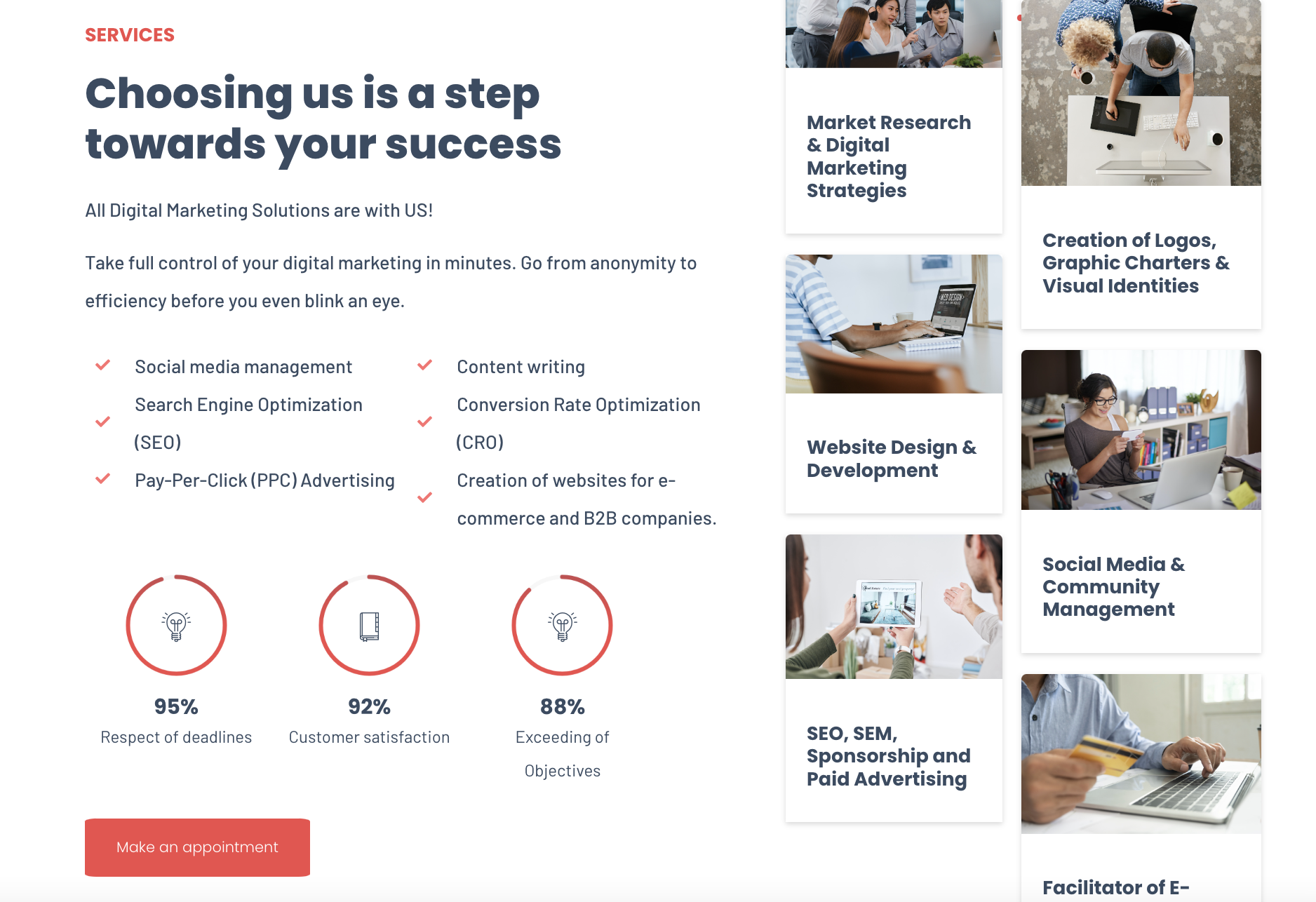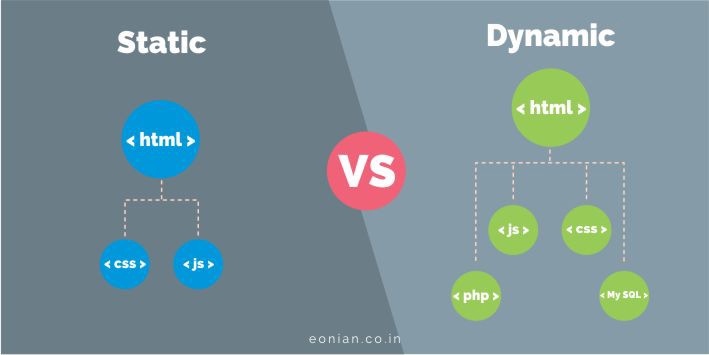
Dynamic Website vs Static Website: Which One to Choose?
Last update: 8 February 2024 at 02:40 pm
Throughout the history of the internet, websites have continued to evolve to improve the experience of brands and their audiences. Due to technological advances, these changes have influenced the way people experience online content.
Modern websites are optimized to be viewed on any device – laptops, tablets, and even smartphones – and have become more intuitive.
With the growing popularity of smart assistants, pages have also incorporated voice search features for a user-friendly browsing experience. Among all these exciting updates, one of the most useful features is the dynamic website.
What Is a Dynamic Website
A dynamic website is a website that displays different types of content each time a user visits it as each update on the site is automatic.
This display changes based on a number of factors such as:
- User demographics,
- Time of day,
- Location,
- Language settings,
- Etc.
A dynamic site offers unique content to visitors each time they visit the site. This is done through a combination of client and server scripts. Software generate dynamic web pages with the languages :
- PHP
- Java Server Pages (JSP)
- Active Server Pages (ASP) …
Thus, a dynamic web page can provide information to users depending on their navigation on the server. Two users can simultaneously consult the same web page without having the same content displayed on the screen, unlike a static website.
What Is a Static Website?
A static website is a website whose content is fixed and does not vary according to the characteristics of the demand. That is to say that users who request the page at the same time receive the same content.
In a static website, for each page of the site that we want to create, we create a corresponding HTML document according to the data stored in the server.
We say that a web page is static when the server remains static for the creation of the web page. It does nothing to readjust the web page, it only retrieves it as it is from the server.

Static pages, therefore, imply that the pages – frozen – already exist on the server. An update in a static site must be manual.
These web pages are then called static because their content never changes. It is the same for all visitors and is usually created by a webmaster or your web design agency.
The static web page has another particularity. The code of the programmed page is the same as the code of the displayed page. Programmed page = displayed page.
Thus, the editor of a static site writes and saves each page in an HTML file (which has either the extension .htm or .html).
Difference Between a Dynamic and Static Website
There are two main types of websites: static and dynamic.
- Static web pages are the most basic type, without coding or customizable databases. It is the easiest web page to create.
- Conversely, dynamic web pages can display different contents belonging to the same source code, something that makes them more dynamic and sophisticated.
- A static web page is simple to design while dynamic web pages are complex to build.
- A static web page incorporates technologies such as HTML, JavaScript, CSS, etc. for its construction. On the contrary, a dynamic website is also designed with HTML, JavaScript, CSS but also uses code languages such as AJAX, ASP, PERL, PHP…
- Static web pages display the same content on each visit. While the dynamic website has a database that allows the page to change according to the user.
THE ASSOCIATION OF THE TWO
A site can also be composed of static web pages and dynamic pages if it requires pages stored in the server and others generated at the same time of the search. In fact, almost all modern and successful sites are a mix of both.
Advantages and Disadvantages of a Dynamic Website
Advantages
- More profitability, because the formatting of a dynamic web page reduces the interventions and facilitates the change of the contents in an autonomous way.
- Maintenance of the website is less expensive because you don’t need to call a webmaster or your agency for each modification.
- Possibility of modifying, deleting, or adding the content of your website directly.
- Immediate transformation when you want it without prior training.
- Your customers can testify, vote, and give their opinion on your products or services.
- Possibility to limit the access of your website or a part of it by creating a name and password (example: create a space reserved for your customers).
- Design of an exploitable database in order to optimize interactivity.
- Unlimited number of products (data).
- Search engine is in-house in order to better respond to any request from Internet users.
- The Internet user will regularly visit your site to consult your new offers.
- Excellent return on investment.
Disadvantages
- The process of creating a dynamic website is much more complicated than creating a static web page
- Designing a dynamic web page requires a professional webmaster or an experienced web design and management agency.
- Pages are generated on the fly which makes the website more loaded and therefore can take longer to load, something that can be improved with tools like CDN (Content Delivery Network), Caching and code optimizations.
- Each page will have a unique identifier, a title, a description of its own and a single parent, which makes the work of SEO more difficult because the search engine can not easily judge and track the relevance of the page generated for the user.
Examples of Dynamic Websites
A dynamic web page meets the need for customization of a website display. Before their creation, it was not possible to have different contents according to the choices of Internet users.
- An e-commerce site / online catalog
The page of a product catalog on an e-commerce site or online catalog where the user selects parameters
- Size,
- Color,
- Shape,
- Price,
- Delivery date,
- etc.
From this selection, a page with appropriate content is created.
It corresponds to the parameters entered by the customer. This page did not exist as it was on the server, it was customized upon request.
- A search engine
Google is the perfect example of a dynamic website. The results pages they propose to visitors correspond to pages generated on the fly, according to the requests of the Internet users.
The latter interact and modify the content of the pages.
- Blogs and forums
Visitors interact and modify the content of the pages according to filters and their preferences for example.
- Institutional website/showcase website
Institutional or showcase websites aim to promote the brand image of a company. It is the showcase of the company on the web.
The information will be presented in a different way depending on the interaction with the user and the search criteria.
Elements of a Dynamic Website
The creation of a dynamic website allows you to elevate the content of your page to be more relevant and attractive to your visitors. Below are some common dynamic website elements that work in a dynamic page setup:
Change based on your screen size
With the wide range of smart devices on the market, a web page that doesn’t fit well can turn off visitors.
Dynamic website development allows the page to display on almost any screen without compromising its visual appeal and intuitive layout.
This includes:
- Rearranging buttons,
- Reformatting text and typography,
- Resizing images to fit the visitor’s screen.
Change the language according to your country
Using a database in a dynamic site, a dynamic web page can be displayed in the language of the region from which the visitor is viewing the page. This makes your content more familiar, while further personalizing the overall experience.
Recommendations based on what you’ve seen before
One of the benefits of integrating cookies into your site is that you have a wealth of information to create a more personalized experience on the site.
Based on a user’s previous visit, a dynamic site can offer similar recommendations. This is useful for sites with a wide variety of content or for e-commerce platforms.
Integration of social networks and new content
One way to add new content to a site is to leverage social media. Page plugins can display new content from your brand’s social media platforms.
Site visitors can see how active your brand is, even if other content on the site isn’t updated as frequently.
Adding these active feeds gives Google and other search engines more content to crawl.
Dynamic visuals and animations
Images are an essential part of any website. With the right image behind compelling text, it can grab a site visitor’s attention almost instantly and encourage them to continue browsing.
With the use of dynamic elements, you can have a slideshow of images that scroll or change when the page is refreshed. These techniques can also be applied to video content and animations.
How to Create a Dynamic Website
Using a website builder
With website builders like Shopify & Wix, businesses and individuals can create and customize a storefront or online store. They can also sell in multiple locations, including web, mobile, in-person, brick-and-mortar stores, and multiple channels, from social media to online marketplaces.
The advantage of this method is that you can easily have a good-looking website with all the basic features for it to work. This is the ideal way for someone who doesn’t have web development skills or a budget to hire a web developer.
On the other hand, in this case lies the limitation of this model: customizations are more difficult to implement and often require either an experienced developer or paid modules/extensions.
Learn how to create your website on a CMS
With a CMS (Content Management System) such as WordPress – Woocommerce, Prestashop, Magento… you will have more possibilities to modify and mold the site to your taste and needs.
The advantage of opting for a site built on WordPress as an example is that its large ecosystem means that there are many free and paid tools that offer you a multitude of customization possibilities and additional options (50,000+ plugins and extensions).
However, creating a high-performance, SEO-optimized WordPress website that converts well requires knowledge of development, UI/UX, HTML, CSS… It also requires – quite frequently – paid extensions that help optimize the website in terms of load time, design and functionality.
Hire a web design agency
If you’re considering hiring an agency to create your website, the good news is that you can find a great provider without breaking the bank.
Choosing an experienced and well-respected web design agency will ensure that your website :
- Will load quickly
- Optimized for SEO
- Its design will respect most UI/UX rules
- Will be configured with all major tools such as Google Analytics, Google Search Console, sitemaps, GDPR, security tools
- Layouts and tips that will help you generate more conversions…
Moreover, they will keep a great reactivity to your requests and will do their best to make your website satisfy all your needs and those of your potential customers.
In addition, it will allow you to devote your time to your core business. And you’ll be able to focus your energy on productive tasks rather than the frustration of learning a new skill that you may only have to use once in your life.
RHILLANE Digital Marketing, Dynamic Web Design Specialist
And if designing a dynamic website still seems confusing, don’t hesitate to contact us to design your website that meets your needs to satisfy your customers and personalize their experience when visiting your website. Or take care of all the digital marketing aspects of your business.
Choosing RHILLANE Digital Marketing for your dynamic website is like choosing one of the best 360° Web Design and Digital Marketing Agency, having successfully completed more than 135 projects to date with Medium and Large Companies.

Our agency adopts working methods that allow you to follow the progress of your project, from its conception to the testing phase, from its publication to its marketing, from customer loyalty to the optimization of conversion rates.
Our development experts and Digital Marketing team will assist you in developing and executing the best possible digital strategy.







